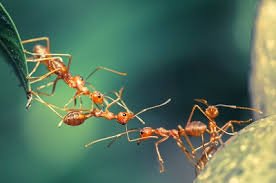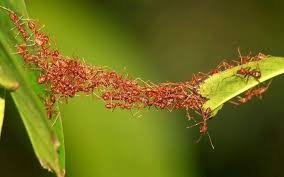The strenght in co-operation: Ant (case study)

Cooperative phenomena in the animal kingdom are very frequent. For example, group hunting enables lionesses to have greater success in capturing preys, especially, those of larger size. Group life allows mothers to care for, feed and better protect their cubs increasing in such a way their survival likeliness until the adulthood. Monkeys, on their turn, live in social groups and this brings to them some important advantages like protection of food sources against competitors, although an increase in the number of individuals in a group can influence the quantity and distribution of the available food in a given environment. This is an important aspect in determining the ideal size of primates’ groups. Other advantages are: avoid predation, generational learning, easy access to mates or breeding partners, infant care, the development of social activities, specially, mutual grooming to reinforce bonds between individuals within the group, etc.
A special case is the case of the Ants.

Ants like Honey bees are eusocial insects that belong to the order Hymenoptera, one of the largest orders of insects. The name Hymenoptera literarily means ‘membrane wings’. Ants have spread through almost the entire world (they can be found in all places on Earth except Antarctica and some isolated islands) and compose about 15–20% of the animal biomass in most terrestrial environments.
The division of labor between ant queens and workers and among different worker subcastes can reach extra- ordinary extremes of complexity. In many aspects it appears more appropriate to treat the colony as a functional unit rather than a group of individuals and it is the colony which must be examined in order to understand the biology of a eusocial species. 
The colonies have different sizes and are comprised of one or a few queens and a cast of female-sterile workers. Each member is assigned a specific role within the colony and the individual actions are governed by simple behavioral rules. The role of male ants is to mate with the queen. The queen is a reproducing adult female and the founder of the entire colony. She is the only one that lays eggs and usually tends to have a long half-life with respect to the workers. The worker ants are non-reproductive females and are responsible for the tasks in the colony. So, we can find individuals specializing in cutting leaves, defending the colony, taking care of larvae by feeding and washing them, fungus growth- as an indispensable mechanism for getting essential nutrients from food- etc. These insects are able to build amazing underground cities with lots of tunnels and chambers dedicated to different purposes: nursery, food storage, garbage dumps, etc. They are also able to fertilize the surrounding soil by means of the variety of nutrients produced around their nests and contribute to the dispersal of seeds; reasons for which they are considered authentic underground factories that play a decisive role in the balance of the ecosystem. They use a chemical language (pheromone markers), sounds, physical touch (they touch one another in certain situations as a stimulus for activating an individual) and diverse environmental cues to coordinate their actions.

Ants formed by the union of a sperm and an egg (diploids) become females, while ants formed by eggs alone (haploids) become males. Because female ants have two chromosomes, half of which are contributed to producing a new ant, each daughter ant shares 50% of her genes with her mother. However, daughter ants always receive all of the single chromosome possessed by her father; this means that she shares 75% of her genes with her sisters. Thus, daughter ants have an incentive to keep their mother safely and continuously churning out fellow sister ants.
This peculiar system of sex determination has made possible a wide variety of cooperative behaviors, which has made ants the poster-child of the burgeoning field of sociobiology. This amazing co-operating behaviour in ants is an attitude worthy of emulation for humans.
